| About | Index | Information about the Shinsengumi collected from across the web
Don't wanna be here? Send us removal request.
Text
Best of 2023
Most Popular
(reblogged posts not included)
Traditional Kimono Colors (170 notes)
Bakusin - The number one website on the Shinsengumi (48 notes)
Okita’s handwriting (44 notes)
Was hijikata married? Or he had lover before? (43 notes)
Hijikata Toshizo’s favorite? A bamboo flute found at the home of a descendant of his brother-in-law in Hino (40 notes)
Shinsengumi Films (39 notes)
Okita Souji’s personality according to an old newspaper article (35 notes)
Anecdotes about Hijikata Toshizo (34 notes)
Hijikata’s favorite flute (33 notes)
Okita Souji’s work schedule, Hijikata’s souvenir teacups from Kyoto, Moeyo Ken English Translation (31 notes)
My Picks
Shinsengumi Handwriting
If Okita never caught tuberculosis and survived to the Meiji Era, what occupation would he have?
A hanging scroll handwritten by Shinsengumi Commander Kondo Isami is found in Kyoto
Shinsengumi avatars
Yahoo Groups ShinsengumiHeadquarters
Okita Souji and his subordinates
The Hijikata family in the Ishida village census
Okita Souji timeline details
Letter from Kondo Isami about male love
An Assassination Attempt on Okita Souji
The Shinsengumi and Religion
Okita’s height
Nagakura Shinpachi’s letter to Sato Hikogoro in 1891
Shimabara (part 1), Shimabara (part 2)
The Courtship of Lady Tokio manga
Flowers and Water manga
Between the Clouds manga
Poem about ayu fish, possibly by Hijikata
List of Letters from the Shinsengumi and Ezo Republic
Bakumatsu period fanfic about the Shinsengumi
Previous years: 2020, 2021, 2022
26 notes
·
View notes
Text
A thought while commuting home tonight:
How did the teacher's great-grandmother know that Okita Soji's body is beautiful?
Hear me out.
When someone is wearing kimono and hakama - two items essential to any samurai venturing outside his own home during the Edo period - there's not actually a whole lot you see of the body.
It's not like modern clothes where you can tell someone has a nice butt in jeans or sculpted abs under a fitted T-shirt.
So, I have this picture of great-grandma (who was, at the time, obviously a young woman), either peeking through the fence or looking over the fence from the second story of her home or perhaps her property's store house (if either of these existed), to catch a glimpse of her Shinsengumi neighbors with their clothes off.
Which makes this whole BL-neighbor-fiction tale even more hilarious.
... also, I'm kinda wondering what gave her the idea to ship Hijikata with Okita in the first place.
What are you two doing in the Shinsengumi camp that is inspiring this woman?
52 notes
·
View notes
Text
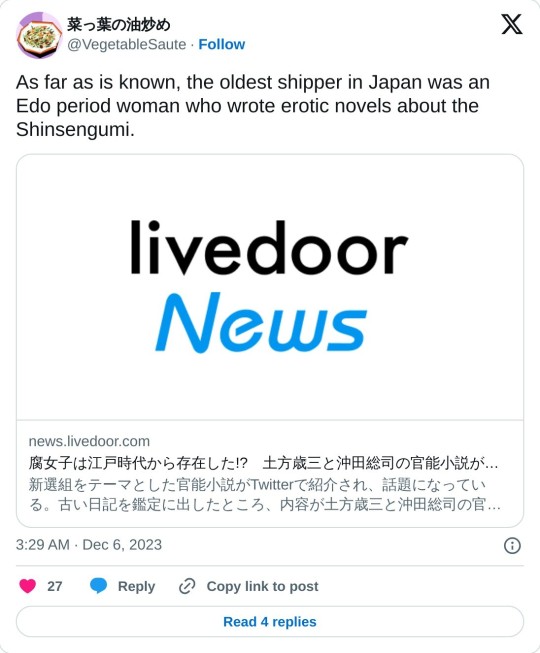
221 notes
·
View notes
Photo
Translation:
"Japanese dogs are very quiet, lying in the middle of the road without barking. Even when we approach, they remain as before, so we always have to avoid them so as not to trample them to death.'' From Schliemann's Travels, Qing Empire (China) and Japan
Near Yokohama, taken by Wilhelm J. Burger, circa 1869, with a sleeping dog on the far right.
Robert Friedrich Blum in 1893, Illustration from “An Artist in Japan” contributed to Scribner’s Magazine, Street Scene in Tokyo
A dog lying in front of the Great Buddha in Kamakura, circa 1904
A dog participating in a procession of monks riding rickshaws, circa 1900
"Illustration of the February Hatsuuma Inari Festival'' from the March 1889 issue of ``Fuzoku Gaho''
Photographed by Arnold Genthe, 1908
"The rickshaw men ran to avoid dogs and cats no differently from the way they avoided children playing on the street. To men of virtue, they were all small creatures that should be cherished." From Watanabe Kyoji, Vestiges of a Passing World, Chapter 12, Living Things and Cosmos
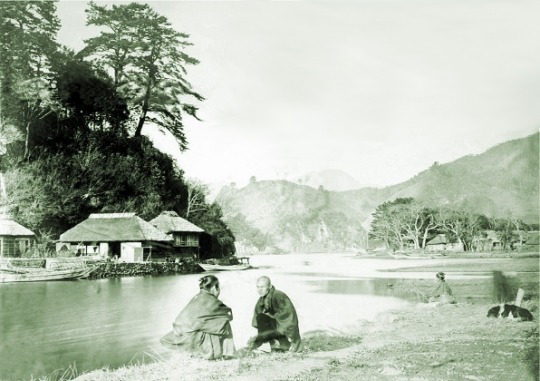
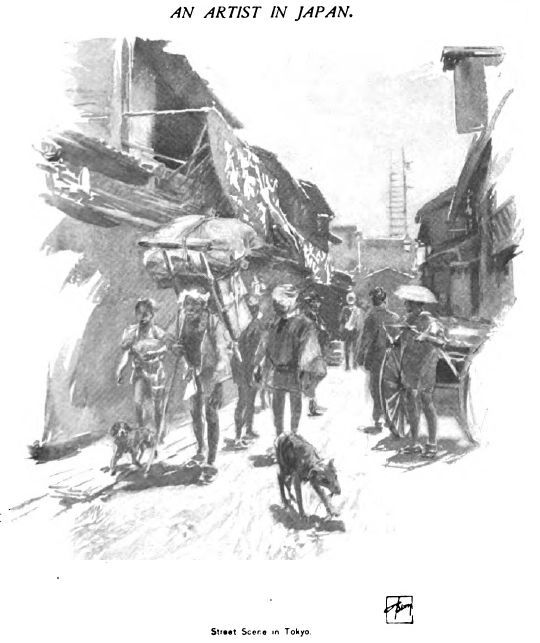




「日本の犬はとてもお��なしくて、吠えもせず道の真ん中に寝そべっている。われわれが近づいても、相変わらずそのままでいるので、犬を踏み殺さないよういつもよけて通らなければならない。」 シュリーマン旅行記 清国・日本 より
一枚目 横浜近く Wilhelm J. Burger 撮影 1869頃 右端で犬が寝ています。
二枚目 Robert Fredrich Blum が1893年に、雑誌 Scribner’s Magazine に寄稿した「An Artist in Japan」の中のイラスト Street Scene in Tokyo
三枚目 鎌倉の大仏の前で寝そべる犬 1904頃
四枚目 人力車に乗る僧侶の行列に参加した犬 1900頃
五枚目 「風俗画報」1889 三月号より「二月初午稲荷祭りの図」
六枚目 Arnold Genthe 撮影 1908
818 notes
·
View notes
Photo
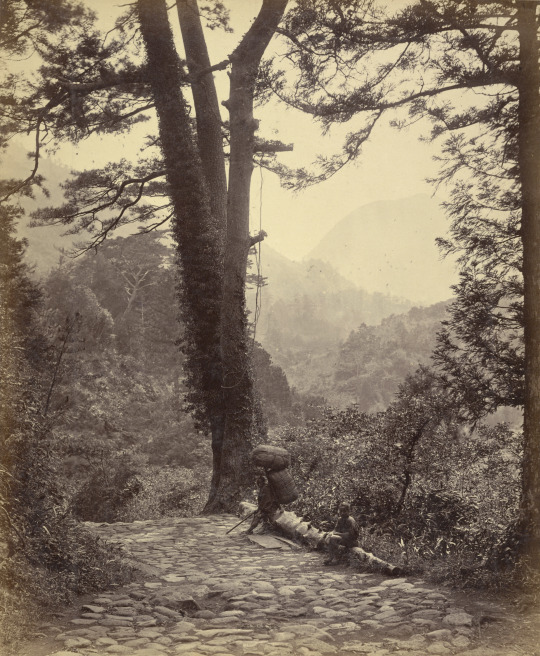
Felice Beato - View of the Hakone Pass Tōkaidō, Japan, 1863-1868
287 notes
·
View notes
Text
Trip to Mibu-dera
I accomplished my long-time dream of visiting Mibu-dera today! The Shinsengumi lived there for a couple of years in their early days ^-^ We couldn’t take any photos inside, but here are just a few of the photos from the day (please excuse my subpar photography lol):

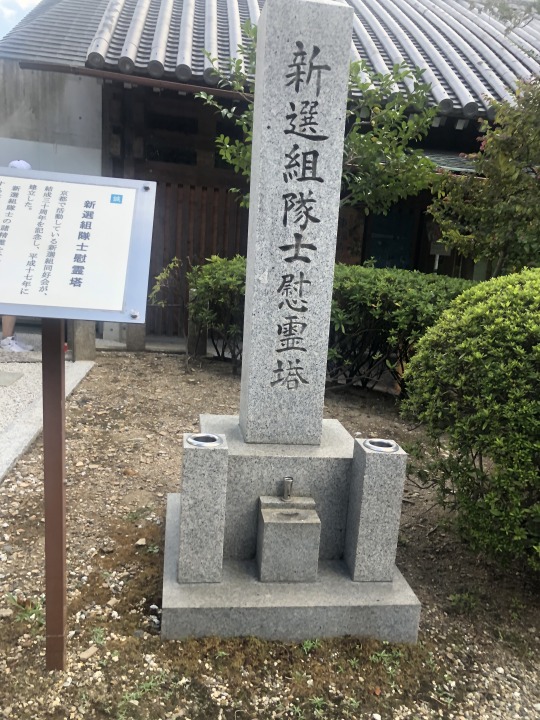
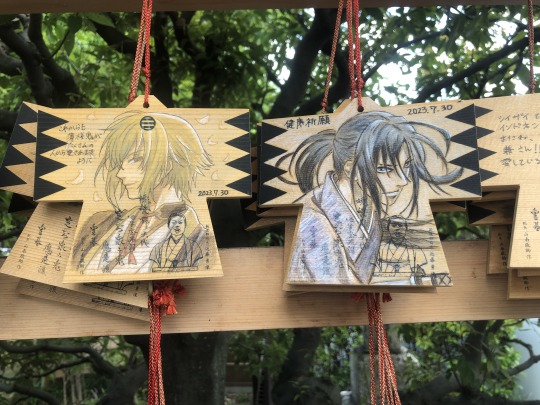

Although we couldn’t take photos inside, I want to mention that the inner part of the main temple was absolutely gorgeous. It was ornately decorated and houses a Buddhist statue that dates back to the Heian period.
In a room on the side of the temple you can see Hijikata and Kondo’s swords, as well as some of their letters. My kanji is limited and I couldn’t take out my phone for translation help, so I’m slightly embarrassed to say that I ended up asking some of the other museum patrons to explain things to me in more simple Japanese. Thankfully, people were really nice and I was able to learn a lot more thanks to them :)
I ended up buying a goshuincho and a bag from the gift shop. For those who don’t know, a goshuincho allows you to collect signatures from the various shrines you visit. The signatures serve as wonderful souvenirs to show where you’ve visited. Today alone I ended up collecting three signatures between Mibu dera, an enmusbi shrine, and then the Go’o shrine near the Imperial Palace.
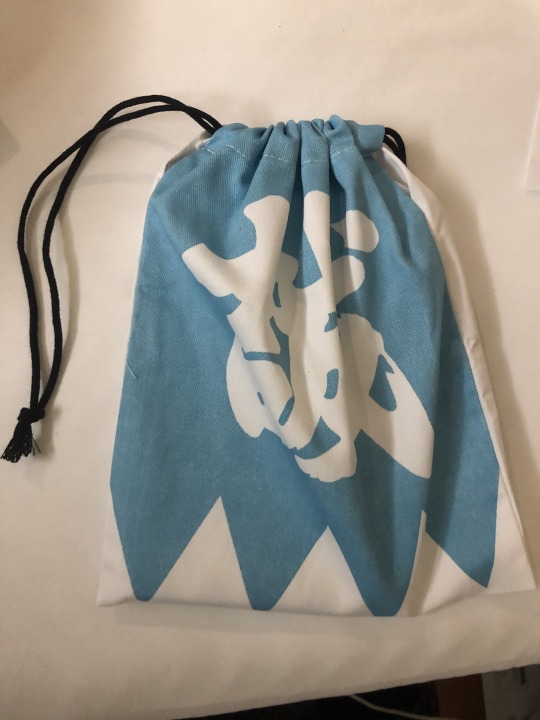


I worked hard touring Mibu dera, so of course I had to treat myself to some Shinsengumi ice cream afterward haha.

As you can see, the ice cream is blue and white, and the little cookie has Makoto inscribed onto it! The ice cream flavor was simple and milky, and the cookie had a pleasant almond taste. It was really refreshing and I recommend it! The shop is called Dandara Coffee and it’s right next door to the temple.
I still intend to go to the Yagi house and various other Shinsengumi spots around Kyoto, but luckily I’ll be studying here until May so I’ve got time! If you have any recommended spots in Kyoto or the surrounding areas (Shinsengumi-related or otherwise), I would love to hear them :D
74 notes
·
View notes
Text



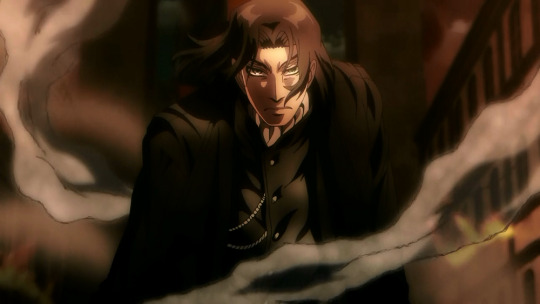


Hijikata looks good in Drifters even as a villain
26 notes
·
View notes
Text
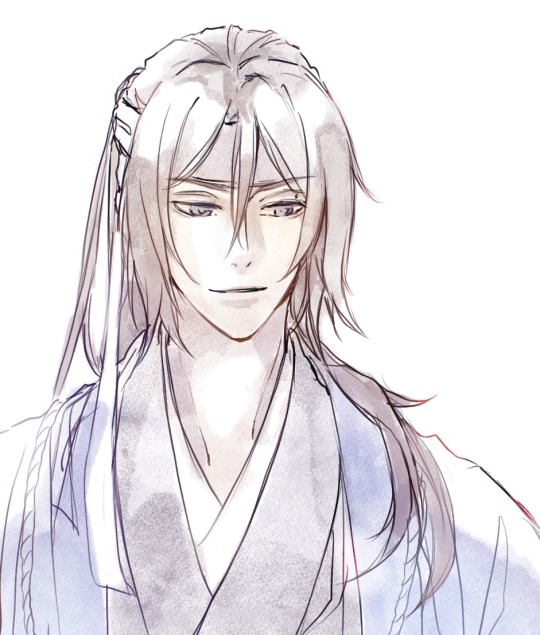
quick oni fukuchou sketch before sleep :]
247 notes
·
View notes
Photo


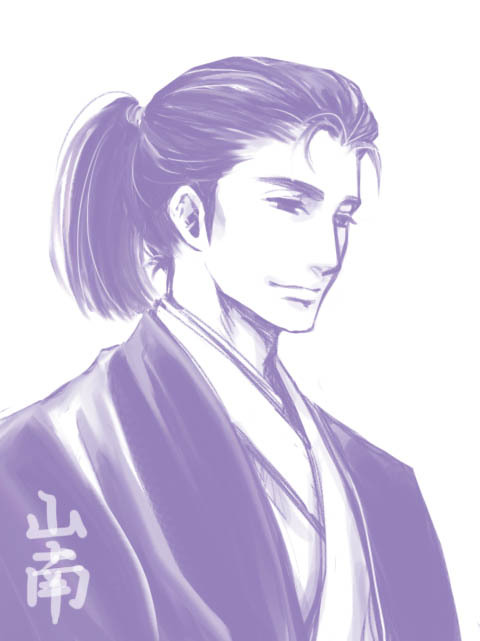




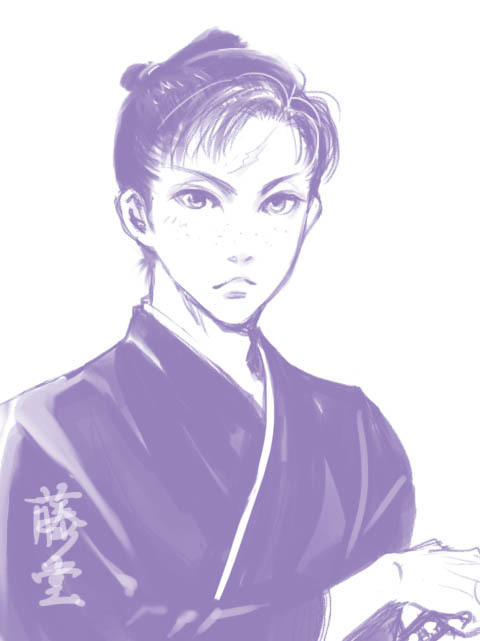
Original Shinsengumi - by Hirosaki
Her original character designs are wonderful; I want to see her take a stab at drawing a Shinsengumi manga!
420 notes
·
View notes
Text
The Shinsengumi Trio
18 notes
·
View notes
Text
I've been thinking about another interpretation of that paragraph. Could that be Kondo coming out to his friend?
For the lines:
さて、先年府中宿おいて御同様はじめ、楼に登り、妄戯仕る事時々思い出し申し候。ついては、当節婦人と戯れ候事いささかもこれ無し。 Now, I sometimes recall that last year when I was in Fuchu, we visited brothels and indulged in raunchy games. In that regard, people no longer play around with the ladies these days.
Since the second sentence doesn't have a subject particle as far as I can tell, is it possible to translate it as "I no longer play around with the ladies these days" instead of "people"? Because if it was "people", it wouldn't be factually correct. The women at Shimabara had plenty of customers at that time.
If we interpret it this way, it would change the meaning of the entire paragraph. He would be bringing up (or possibly exaggerating) the prevalence of male sexuality as justification to make it sound more acceptable that he's no longer interested in visiting the brothel like last time.
It wouldn't necessarily mean Kondo was gay since he could have just preferred more serious relationships with women instead of playing around. But he probably wouldn't mention male sexuality as an explanation unless he was also interested in men.
It would finally make sense why he found it so important to "mention this before returning home". Maybe the "male sexuality is popular" line wasn't his main point.
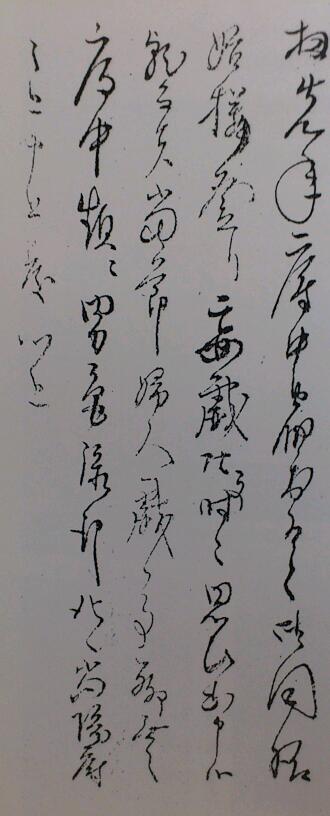
Letter from Kondo Isami dated May 20, Genji 1 (June 23, 1864) to Nakajima Jirobei (中島次郎兵).
The second line from the left reads, "Male sexuality is popular" (男色流行).

Original letter
(本文略) 尚々、御家内中様御尊父始メ御勇猛之至奉恐賀候。陳者尊兄健次郎様事市ヶ谷辺江御縁談之由、恐悦至極奉存候。 次ニ下拙義も素□愚魯身不顧尽忠報国有志御募リ相成、然馬合之局中ヲ預リ、州鄙客申述頻ニ心配致ゆへ□哉意外多病相成、依而去二月肥後守殿□なるへく温泉致候様、依之罷越候処僅七八日ニ而俄ニ 肥後守殿御役替ニ付飛脚到来、其夜五十丁十六里帰京致候。 併相応度候哉当節大丈夫ニ相成候間、御懸念可被下候間敷、且乍憚一統様暫時処公然様奉願上候。 一、扨先年府中宿おいて御同様始楼登リ、妄戯仕事時々思ひ出申候。就而者当節婦人戯候事聊無之。局中頻ニ男色流行仕候。尚帰府之上申上度。以上
Translation
(Text omitted) I would like to express my heartfelt gratitude to all of you, including your dear father, for your bravery. I am very pleased to hear of your older brother Kenjiro's marriage proposal and move to the Ichigaya area. Next, I have been recruiting volunteers to repay the nation with loyalty without regard for my own life, and have been entrusted with the affairs of bureaucrats. I've had too many worries on my mind and I have been unexpectedly very ill. Last February, Higo-no-kami-dono asked me to visit a hot spring, so I did. After just 7 or 8 days, a courier suddenly arrived with news of Higo-no-kami-dono's change of position, so overnight I returned to Kyoto at a distance of 50 blocks and 16 ri [16 hour walk]. At the same time, I would like to express my sincere gratitude to you for your concern. For the time being, I can only offer my best wishes. Now, I sometimes recall that last year when I was in Fuchu, we visited brothels and indulged in raunchy games. In that regard, people no longer play around with the ladies these days. Male sexuality is popular frequently throughout the headquarters. I would like to mention this to you upon my return to my home province. That is all.
Commentary
In the main text (omitted), he writes that he was disappointed in the Shinsengumi's position and its role, and that he considered disbanding the group, but was consoled, and so on. [T/N: This was before Ikedaya]
In the postscript, in addition to congratulating the Nakajima family on their happy event, he wrote that he had fallen ill due to hard work and went to a hot spring for treatment, as recommended by Katamori, but after about a week, Katamori informs him that he was to be reassigned to a different position. It is written that he returned to Kyoto, sick and beaten.
He then fondly remembers how they used to indulge in "raunchy games" together at a brothel in Fuchu, and tells them that these days there is no such thing as playing with women at all, and that "danshoku" (male sexuality) is prevalent within the Shinsengumi.
(source: www.toshizo.com)
Translator Notes
Instead of interpreting it as Kondo complaining about the prevalence of male sexuality, doesn't it sound like he's actually trying to convince Nakajima to go for male prostitutes together next time?
"I know we used to play around with women, but no one does that anymore. Here at the Shinsengumi HQ, we do male love all the time. Just something I wanted you to know before I visit you ;)" 😂
46 notes
·
View notes
Text

Letter from Kondo Isami dated May 20, Genji 1 (June 23, 1864) to Nakajima Jirobei (中島次郎兵).
The second line from the left reads, "Male sexuality is popular" (男色流行).

Original letter
(本文略) 尚々、御家内中様御尊父始メ御勇猛之至奉恐賀候。陳者尊兄健次郎様事市ヶ谷辺江御縁談之由、恐悦至極奉存候。 次ニ下拙義も素□愚魯身不顧尽忠報国有志御募リ相成、然馬合之局中ヲ預リ、州鄙客申述頻ニ心配致ゆへ□哉意外多病相成、依而去二月肥後守殿□なるへく温泉致候様、依之罷越候処僅七八日ニ而俄ニ 肥後守殿御役替ニ付飛脚到来、其夜五十丁十六里帰京致候。 併相応度候哉当節大丈夫ニ相成候間、御懸念可被下候間敷、且乍憚一統様暫時処公然様奉願上候。 一、扨先年府中宿おいて御同様始楼登リ、妄戯仕事時々思ひ出申候。就而者当節婦人戯候事聊無之。局中頻ニ男色流行仕候。尚帰府之上申上度。以上
Translation
(Text omitted) I would like to express my heartfelt gratitude to all of you, including your dear father, for your bravery. I am very pleased to hear of your older brother Kenjiro's marriage proposal and move to the Ichigaya area. Next, I have been recruiting volunteers to repay the nation with loyalty without regard for my own life, and have been entrusted with the affairs of bureaucrats. I've had too many worries on my mind and I have been unexpectedly very ill. Last February, Higo-no-kami-dono asked me to visit a hot spring, so I did. After just 7 or 8 days, a courier suddenly arrived with news of Higo-no-kami-dono's change of position, so overnight I returned to Kyoto at a distance of 50 blocks and 16 ri [16 hour walk]. At the same time, I would like to express my sincere gratitude to you for your concern. For the time being, I can only offer my best wishes. Now, I sometimes recall that last year when I was in Fuchu, we visited brothels and indulged in raunchy games. In that regard, people no longer play around with the ladies these days. Male sexuality is popular frequently throughout the headquarters. I would like to mention this to you upon my return to my home province. That is all.
Commentary
In the main text (omitted), he writes that he was disappointed in the Shinsengumi's position and its role, and that he considered disbanding the group, but was consoled, and so on. [T/N: This was before Ikedaya]
In the postscript, in addition to congratulating the Nakajima family on their happy event, he wrote that he had fallen ill due to hard work and went to a hot spring for treatment, as recommended by Katamori, but after about a week, Katamori informs him that he was to be reassigned to a different position. It is written that he returned to Kyoto, sick and beaten.
He then fondly remembers how they used to indulge in "raunchy games" together at a brothel in Fuchu, and tells them that these days there is no such thing as playing with women at all, and that "danshoku" (male sexuality) is prevalent within the Shinsengumi.
(source: www.toshizo.com)
Translator Notes
Instead of interpreting it as Kondo complaining about the prevalence of male sexuality, doesn't it sound like he's actually trying to convince Nakajima to go for male prostitutes together next time?
"I know we used to play around with women, but no one does that anymore. Here at the Shinsengumi HQ, we do male love all the time. Just something I wanted you to know before I visit you ;)" 😂
46 notes
·
View notes
Text
youtube
Aoi no Miburo
A new anime about the Shinsengumi was recently announced. Looking forward to it!
Here are some character profiles from the official site:
Saito Hajime

He's the same age as Nio (the protagonist) and was recruited by Kondo to join the Miburo. He's skilled in swordsmanship and good at iaido. He is obsessed with "strength" due to his past experiences.
Hijikata Toshizo

He's the person who brought Nio into the Miburo because he felt they were similar. Like Nio, he is straightforward in his desire to "make the world a better place".
Okita Souji
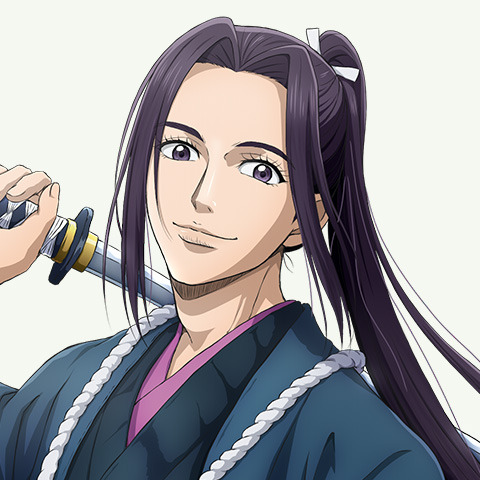
A kind person who always has a smile on his face. A swordsman who simply wants to fight with the strong.
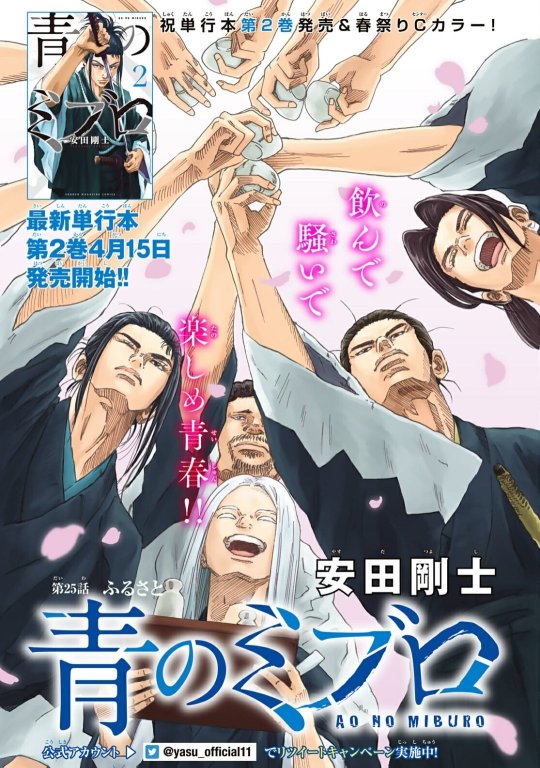
It's based on a manga with the same name. The first few chapters are available online. There are only 2 chapters with English translations on Mangadex, but chapters 1-9 with Vietnamese translations are available at: vlogtruyen5 dot com/ao-no-miburo/chapter-9-61cd751bab4d7a24ac7c1332.html
11 notes
·
View notes
Text
An easy way to date photos from the end of the Edo period: if there's a rickshaw in the photo, it was taken during or after 1869, so it's not an Edo period photo.
Because that's the year the jinrikisha was invented in Japan, and it spread very rapidly from there: some 200,000 were in use across the Japan by 1896 and export to other Asian countries had begun in 1874.
27 notes
·
View notes
Note
Hi, sorry for this random (and probably very stupid) question, but do you know if any member of Shinsengumi had tattoos?
I don't think the question is random or stupid; no need to apologize for your curiosity!
That said, unfortunately I don't have a clear yes or no answer for you.
I can tell you that I don't remember reading any mentions of tattoos among Shinsengumi members. I think a tattoo would have been uncommon enough in the group that people would have noted it in writing or perhaps mentioned it during interviews.
I do have a more general article about tattoos at the end of the Edo period here.
Tattooing was increasing in popularity in the 1800s, enough so for a magazine to complain about all these people covering their skin with ink, but also enough that the government passed a series of laws on the matter.
Looking at photos from the end of the Edo period and early Meiji period, tattoos seem to mostly have been a trend with townsmen - merchants, artisans, firefighters, couriers, palanquin carriers, and so on - but there are some references of small tattoos among courtesans and (supposedly) samurai.
It would have been a really rare occurrence for a samurai to have a tattoo, although the text quoted in that other post suggests that temporary tattoos, painted on for special occasions, was an alternative option. That seems to have been a fairly brief fad, perhaps already outdated by the 1860s, however.
7 notes
·
View notes
Text
My fan/amateur scanlation of Asagi Iro no Kaze, a shoujo manga about the life of Okita Sōji by Satonaka Machiko. The manga was first published in 1984, and you can buy reprinted paperbacks/kindle editions on Amazon (Japan).
14 notes
·
View notes
Text

Shinsengumi Japanese zodiac.
(I used a Zodiac calculator to figure out the zodiac for each person based on their birthday, and pulled info about the zodiac traits from two different websites.)
Kondo Isami (9 Nov 1834)
Horse 午. Horses are cheerful, sociable, and decisive. They are also versatile and excel in many fields, but tend to get bored easily and leave things unfinished. They do not like to work for other people because they appreciate their freedom. They never let opportunities pass, although sometimes they tend to be a bit imprudent. They exhibit a vain streak and are big spenders. Horses are skillful in paying compliments, likely to get into trouble for a slip of the tongue, and quick to catch on to a trend.
Hijikata Toshizo (31 May 1835)
Sheep 未. Sheep are caring, considerate, sympathetic, and cherish friendship. They always seek out other people. They are endowed with artistic talent, and are passionate in whatever they do and believe in. They are also noble and generous. However, they can be sensitive and tend to worry unnecessarily over small matters. Sheep are keen to learn new things, always complaining, and often suffer from insomnia.
Sannan Keisuke (5 Feb 1833)
Snake 巳. Snakes are deep thinkers, great observers, and possess tremendous wisdom. Snakes think things through before speaking. They do not like conflicts, and get along with anyone. However, their tendency to avoid conflict can put them under considerable stress. They can be overly logical, distrustful, or jealous. Snakes are fortunate in money matters, have introverted natures and are sometimes not good at expressing themselves. Snakes take failures very personally.
Okita Soji (8 July 1842)
Tiger 寅. Tigers are proud, courageous, and generous. Being decisive and quick-witted, they are potentially great leaders. They are very competitive; they don't give up, and they really like the feeling of winning. On the negative side, they do not like to follow orders, can cause interpersonal friction with others, and can impulsively act on their emotions. Tigers do not make plans, sometimes fail due to overconfidence, and have great sympathy for those they are close to and love.
Saito Hajime (18 Feb 1844)
Dragon 辰. Dragons are energetic, brave, honest, and can inspire trust in almost everyone. They are ambitious in their self-improvement, charismatic, and confident. However, they are also short-tempered and very competitive, so they tend to have as many enemies as friends. Dragons work better as individuals than in groups and speak their mind without reservations. They always help the weak.
... And for good measure, the zodiac for Okada Izo as well, since he's kind of taken over my tumblr.
Okada Izo (14 Feb 1838)
Dog 戌. Dogs are patient, strong-willed, and honest. They have a strong sense of duty and loyalty, and always strive to succeed. They are the protectors of their family and friends. However, they are also very stubborn, and do not like to admit their own faults. Dogs tend to easily get into negatives thoughts, but they can be trusted with secrets and inspire confidence in others.
68 notes
·
View notes